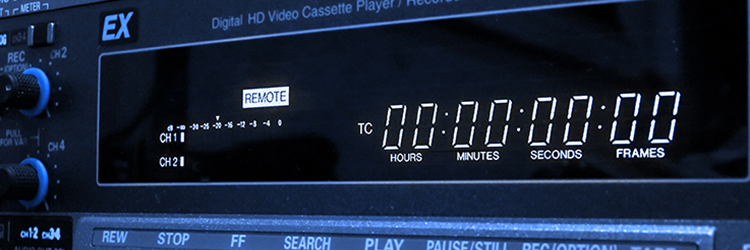 Another great contribution from our very own Paul Turner!
Another great contribution from our very own Paul Turner!
It All Has to do With the History of NTSC
The idea of timecode has been around since the very earliest days of TV, and has its origins in the idea of keycode in film negatives. The idea is simply to uniquely identify any individual frame in a piece of media. A simple frame count would do this, but few people could envision where, in time, frame 213,452 is. So timecode uses the idea of a frame identifier being designated in HH:MM:SS:FF, frame 213,452 translates to 01:58:35:02 (at 30 frames per second).
Simple, right? Well, it was that simple in the days of black and white TV. But when color TV was created, it had to be compatible with black and white TV – so a B&W TV could still create a picture from a color image. So the engineers had to create a way to add color information to a B&W image so that a color set could recreate the colors, but a B&W set would simply throw away this additional information and still make a B&W image. This was done by choosing a very specific frequency of sine wave (which was called “subcarrier”), and adding the color information to that sine wave. The B&W TV would simply treat this as part of the B&W image, but wouldn’t try to decode the color information. As long as the presence of the subcarrier produces imperceptible degradation to the B&W image, all is good. Very clever indeed!
The frequency of the subcarrier was chosen so that, for a constant color, at the same point horizontally on a line, there was a 180 degree phase shift in the sine wave. Your eye averages these 2 sine waves (that’s what your eyes do), and, as you know, the result of adding a sine wave to the inverse of itself, the result is 0 – no noticeable impact of the new color information on the B&W set. Very, very clever!
More Issues
Ahh – but there was one more problem: having worked all of this out, engineers discovered an issue. In analog broadcast TV, the audio was also modulated onto an audio subcarrier, and it turned out the the color subcarrier and audio subcarrier interfered (“beat”) with each other, and you could now see this interference in the picture. DANG!!! Without going into all of the technical details, the solution to this was to reduce the frequency of the color subcarrier, which had the effect of lengthening the duration of a frame, giving it a frequency of 29.97 frames per second. Very, very, very clever!
The timecode numbers now don’t match, though. You see, in 1 hour , at 30 frames per second, there are 10800 frames. So frame 10800 starts exactly 1 hour into the program. But at 29.97 frames per second, it is 1 hour and 3.5(ish) seconds into the program. So a frame of a black and white program that was exactly 1 hour into the program when originally recorded in the days of black and white, would appear to be 3.5 seconds later when shown in the world of color. The longer the program, the greater the error. Oh-oh: a major inconsistency in the TV station (though by and large the viewers don’t care)
 The Solution
The Solution
To fix this, engineers came up with drop frame timecode. In spite of what the name implies, no video frames are dropped (skipped) using drop-frame timecode. What’s actually being dropped are some of the timecode “labels”. In order to make an hour of timecode match an hour on the clock, drop-frame timecode drops frame numbers 0 and 1 of the first second of every minute, except when the number of minutes is divisible by ten. It’s horribly complex to explain in today’s world, but nonetheless, media companies can choose to count in drop frame, or stick with the original timecode counting scheme (intuitively called “non-drop frame timecode).
Why do you care? Because some non-drop frame numbers don’t exist in drop frame timecode. For example, there is no 01:09:00:01 in drop frame. So if you’re trying to seek to that timecode in a clip that uses drop frame, you’ll NEVER find it.
Ah well. If you know about it, you can use mathematics to convert. But you have to understand drop frame. And now you do!!!


In Screenflow, can the timecode be printed on the video? Students and I prepare and present a lot of videos. Often questions are reserved until completion of the video. Questioners would like to reference their questions to the time in the video where the issue arises — like slide numbers in powerpoint talk or page numbers in a book.
HI Jon,
There’s not a way to display the timecode of the video automatically on your video, but one thing you could do is record and edit your video. When you’ve made all your edits and it’s almost ready to go, do a new recording of your ScreenFlow document. Once recording has started, press the play button on your ScreenFlow document to play the video through. Then, you can take that recording, crop it to just show the timecode window, and overlay that into your project so that it displays on top of your video. Hope that helps!